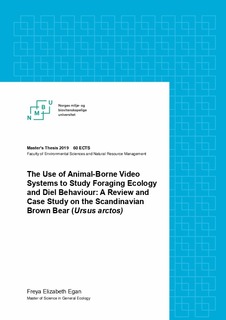| dc.description.abstract | Animal-borne video systems, also known as Crittercams, were developed by Greg Marshall in the 1980s to capture video footage from the animal’s perspective. Primarily deployed on marine species, such as attached to the carapace of green sea turtles (Chelonia mydas), animal-borne video systems have allowed researchers to gain novel insight into the behaviours and trophic interactions of elusive species. The objectives of this thesis are to review the published literature on animal-borne video systems in relation to foraging ecology and diel behaviour to provide a current synthesis of the capability of the technology and areas which require improvement. As well as present a case study on the use of video camera collars on Scandinavian brown bears (Ursus arctos arctos), with regard to their diel behaviour, food item consumption, and ungulate kill-rates. Literature was retrieved from online publication databases using keywords and sorted into six categories; reviews, methods, killrates, diet, activity patterns, and foraging behaviours which formed the basis of the review. The case -study was carried out in northern Sweden in 2017 and 2018. During this period, 4 brown bears (1 male, 3 female) were captured and fitted with video camera collars as well as a GPS tracking device. Video clips were recorded for 5 or 10 seconds every 3.5 or 5 minutes and all data were stored on board. Clips were then classified by behaviour (such as feeding or resting) and feeding behaviours were subcategorised into food items (reindeer calf Rangifer tarandus f. domesticus, moose Alces alces, vegetation etc.). For one bear, a reindeer calf kill-rate was estimated by the number of calves killed that were visible on video during deployment. To substantiate the video data kill-rate estimations, field observations were carried out at GPS cluster locations for one bear to look for carcasses. Animal-borne video systems enable further insight into cryptic species’ diel activity, foraging behaviour, diet, and kill-rates. The use of this technology is still uncommon and it is limited by cost, weight and size, and battery life, however, there are a number of published studies which demonstrate its capabilities and the advantages it can have over other commonly used methods. The case study yielded 23 hours of useable video footage and showed that the bears in Spring spend the majority of time travelling whilst the Autumn bears were primarily resting or feeding on vegetation. Food item consumption was dependent on time of year and the results from the video data reflect those of previous research. It was estimated that 0.6 reindeer calves were killed per day from the video data, but field data revealed a higher estimate of 1.3 calves per day due to difficulties identifying foods consumed as a result of poor clarity. Animal-borne video systems are a suitable method to study foraging ecology and diel behaviour in many species. The technology is not without limitations, however, and in order for this method to be more widely applied these limitations must be reduced. | nb_NO |

